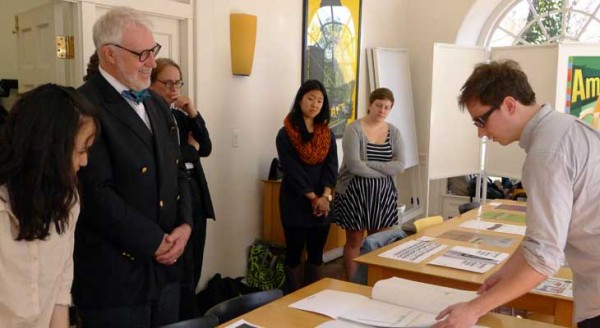AIGA Chief Advises Students

(Original Story from risd.edu)
AIGA CEO Richard Grefé responds to a presentation by senior Micah Barrett 12 GD.
A Art students and politicians don’t usually speak the same language, much less collaborate towards a common goal. At RISD, however, students are both encouraged to explore these unique collaborations and given the opportunity to work with some of the best political strategists in the business.
In April Richard Grefé, executive director of AIGA, the professional association for design and a renowned political tactician, visited RISD to critique the work of students engaged in public policy initiatives. During his visit, he met with two separate groups: the STEAM team and a collection of students working on policy-related independent study projects.
The STEAM team is a select group of students working with RISD’s Government Relations Office to garner support within the government for the RISD-led STEM to STEAM initiative. The idea behind STEM to STEAM is to add art and design to the national STEM (Science, Technology, Engineering and Math) education and research agendas as a means of spurring innovation and global economic competitiveness. Sarah Pease 13 FD, Carly Ayres 13 ID, Arthur Yidi 14 GD, Annie Wu 13 ID and Yu Been Lee 12 GD presented the work they’ve collectively created to direct, promote and garner support for STEAM.
Among the pieces presented were original research and an accompanying info-graphic identifying members of the US Senate who consistently support the arts; a STEAM logo and website; a survey designed to identify and target STEAM audiences; a reinterpretation of “innovation” and its correlation to US R&D policy; and a wall-sized map tracking everyone who interacts with the STEAM movement.
Grefé encouraged students to take a step back from the impressive body of work and redefine their goal. “What you want to do is to create demand for your idea rather than understanding,” he noted. “Is your desired outcome [simply] STEAM, or is it to create understanding of the value of creativity within our education system?
CLARITY AND BREVITY
Grefé also reminded the group to clearly identify their audience. Clarity and brevity, he explained, are crucial to garnering support from individual policy makers. “Politicians will walk down the hallway and an aid will hand them a piece of paper explaining the issue, which they will then crumple up and throw away before they walk into the chamber to vote,” he pointed out. “You have one paragraph – two at most – to explain what you’re asking for.… It’s about understanding [and] the designer is the final step in that.”
In the end, Grefé congratulated the team on their impressive collective accomplishments, saying, “You should be commended. This is about imagining the meaning of the story, and the complexity, clarity and visualization [of your work] is great.”
The AIGA chief then moved on to Market House, where he reviewed the work of Graphic Design and Illustration students who are working independently on various aspects of public policy. Kelsey Lim 14 GD and Keela Potter 14 GD presented their idea for RISD Votes, an initiative to help RISD students register for absentee ballots and raise awareness about the role of the designer in a democratic society. Micah Barrett 12 GD explained his semiotic humanization of data, and Emily Albert 13 GD shared her “social decision aid” designed to explore public opinion.
Both Alaina Nuehring 14 IL and Tabitha Yong 13 GD presented work they had created in Making It Understandable, a Wintersession class taught by Lindsay Kinkade MFA 10 GD and focused on helping the general public better understand the Affordable Care Act. Nuehring presented a collection of knitted hats she had made to personalize the new health insurance exchange and introduce the act to Rhode Islanders. Yong shared her Pocket Information iPhone application, which enables individuals to keep track of their health insurance and medical information in a single dashboard system. This work is a conversation starter with Rhode Island and national policy leaders, and is quickly finding its way into public discourse, notes Babette Allina, RISD’s director of Government Relations.
The presentations aligned perfectly with Grefé’s personal aspirations for young designers. “The reason it’s so important to get designers engaged is that from the time they’re teenagers, they frequently try to define themselves as different from everyone else – they marginalize themselves,” he pointed out. “We need to move designers from the margins to the center and make us politically equal.” In fact, he adds, “the next level of design is leadership.”
Each student left Grefé’s critique with new insight. “I took what he said to heart,” Pease said. “He really knows what he’s talking about, he helps you make connections, and he really believes in the combination of policy and design.” Besides, the Furniture Design junior added, it’s always great to go beyond the “RISD bubble” and find out that “someone in the profession believes in us, too.”
—Samantha Dempsey 13 IL